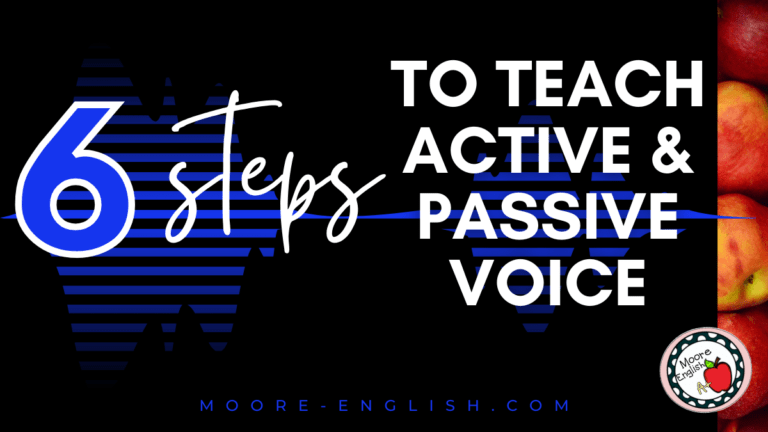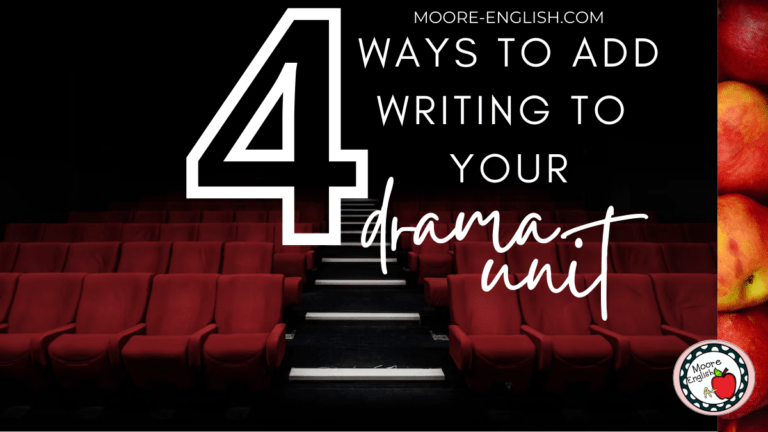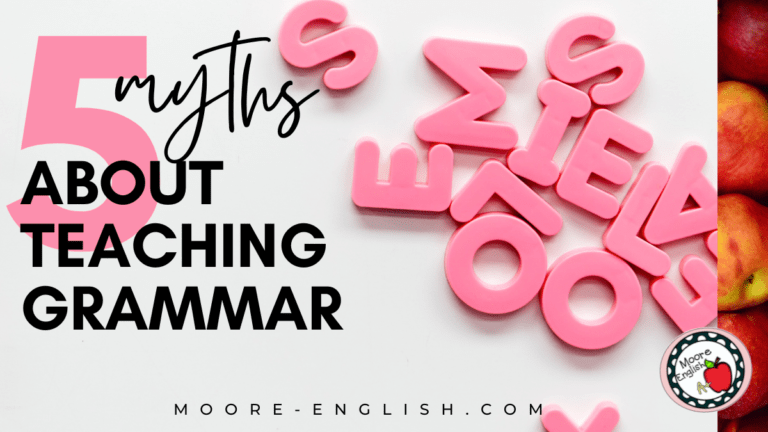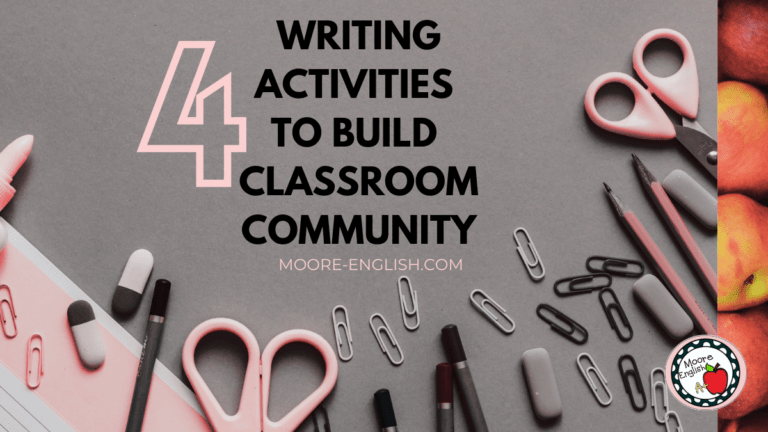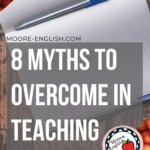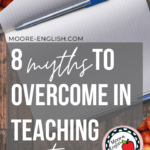The weekend before Thanksgiving, I hunkered down on my sofa to grade sophomore informative papers. As I was grading, I recognized some common strengths and struggles in my students.
Some strengths are clear reflections of our recent work on embedding quotations and citing evidence. And some struggles suggest we should have spent more time brainstorming.
However, some struggles are so pervasive and happen across so many classes and grade levels that the source can only be one thing: myth.
According to Professor Bruce Lincoln*, myths have both authority (unlike anecdotes) and credibility (unlike legends) and can “effectively mobilize a social grouping.”
As Chimamanda Ngozi Adichie’s single story reveals, myths can be dangerous. Myths can unite us, divide us, and may never once be true.
So today I want to bust some myths about teaching writing.
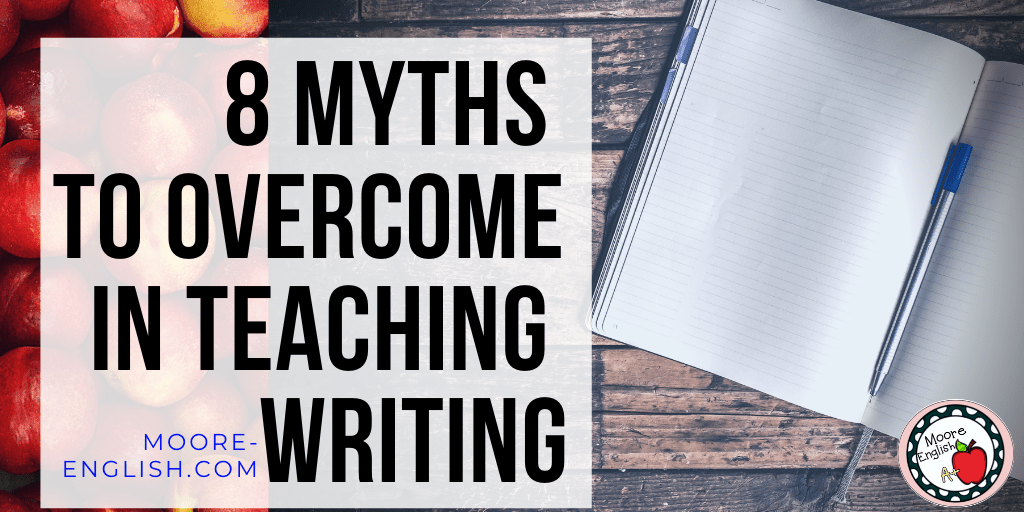
This post this post may contain affiliate links. Please read the Terms of Use.
Myths About the Writing Process
The writing process is at the heart of writing instruction. From 6+1 to Common Core, the writing process is alive and well in education. However, as teachers we can buy into some myths about the writing process.
- Myth #1: Students have internalized the writing process when they arrive. Um…no. As an ELA teacher, the writing process will be on my tombstone, but my students are not writing professionals. Even at the secondary level, it’s always worth reviewing the steps in the writing process and discussing the value of process writing. After all, one of Zimmerman and Hutchins’ keys to understanding is to active prior knowledge. That’s the first part of scaffolding students to higher skill levels.
- Myth #2: Peer revision does not work. I have to admit that as a new teacher, this was one of my cardinal beliefs. As a student, I never had a positive experience with peer revision, so I thought it couldn’t be done. However, after a group of students asked to engage in peer revision, I developed this system of peer revision and this tool. This has been a huge benefit to my students and helps improve their confidence as writers and teaches the importance of discussing writing and revision.
- Myth #3: Students speak teacher. Miscommunication is part of life, but as communication arts teachers, we can help minimize miscommunication in the writing process. For example, when teachers describe a paper as having or lacking “voice,” students may not understand what that means. The same is true of words like “flow” and “awkward.” Rather than provide students with empty, meaningless feedback, try explaining specifically what students can do to improve. For example, an awkward sentence may have too many commas, a misplaced modifier, or may be passive. Similarly, a sentence that lacks “flow” may need a transition word or phrase.
Myths About Quality Writing
More than once, I’ve had a conversation with my math and science colleagues about the difficulty of grading writing.
On one hand, most of my colleagues recognize the value of writing to understand. For example, writing lab reports helps students internalize the scientific method and process the outcome of an experiment.
However, many times have I heard my colleagues wonder at the difficulty of grading writing. The challenge often comes in two parts: grading writing well takes time. And, while identifying quality writing may be easy, explaining what makes quality writing is difficult. That’s where these myths about quality writing begin.
- Myth #4: All papers have to be written in a prescribed order. This is another myth I used to believe, but the more writing I do on my own and the longer I teach writing, the more I come to believe that there is not one perfect order for writing. Now, I teach papers in “stages” rather than in a prescribed order. For example, my juniors are working on argumentative writing, and everyone is writing different paragraphs in different orders. And that’s fine. The final rubric is the same for everyone, but the way students reach that goal should be unique.
- Myth #5: A paragraph is 5 sentence. Oh, if I could meet this myth maker! There is no set length for a quality paragraph. There’s just not. Some writers are masters of concision, and others need to unwind their thoughts.
- Myth #6: More is more. This myth is as much about grading as it is about writing. But at some point in their educational careers, my students started to play “school.” And one of the rules of “school” is that the more words you put on a paper, the better the grade will be. In other words, if students can fatigue their teachers into an A, then they had succeeded. While paragraphs do not have set lengths, they also do not need to be ponderous excursions into the “secret griefs of wild, unknown men.”
- Myth #7: Students ignore rubrics. This one isn’t so much a myth as it is a self-fulfilling prophecy. In other words, if teachers let students ignore rubrics, then they will. However, rubrics have two great benefits: they speed up grading, and they should clearly communicate expectations. For this reason, when using a rubric (like my favorite rubric for short writing), give it to students up front and reference it often. Reference the rubric when discussing assignment expectations. Then reference the rubric when evaluating exemplar texts. Reference the rubric when conferencing with students. Keep referencing the rubric. Use a rubric every chance you get. Eventually, this becomes a habit for you and for students. Read more about how the laundry approach to grading changed my life!
The Myth of Absolute Voice and Choice
In recent years, voice and choice have become clarion calls in education. And, let’s be clear, students learn more when they are engaged. It’s also true that having voice and choice does help students engage in content.
However, in the words of Dave Stuart Jr. (who wrote two of the best education articles of the year), only teaching students to work with what they like is “gilded foolishness.” Learning comes from discomfort.
In Piagetian terms, assimilation and accommodation are arduous tasks, and these complex processes can be challenging. Or, if you’d prefer the words of Peter Elbow, “there’s violence in learning.” Either way, this means that students should experience content, skills, and processes that push them outside their comfort zone. This is how students explore new ideas.
While this doesn’t mean students should have zero opportunity to guide their learning, it also means that it’s time to put to rest Myth #8: students should only write about what they want to write about. In other words, there are times when students should and will write with the familiar, but there are also times when students will write about something foreign, unfamiliar, and, perhaps, uncomfortable. And that might be the time when they learn the most.
*In college, I took a class called Religion, Ethnicity, and Race. The course forever changed my understanding of the world, especially in regards to how society creates “knowledge.” The first text we read was Bruce Lincoln’s Discourse and the Construction of Society, from which the earlier quotation appears. To say that this book radically altered my perception would be an understatement.



